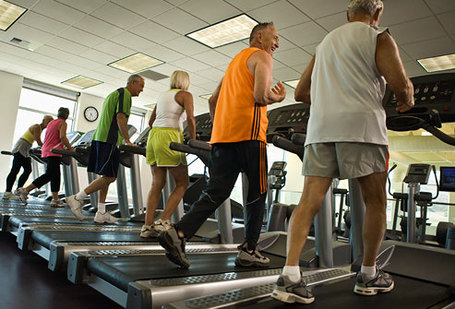
It's so nice to run again. There really is no substitute for this most basic of exercises. I've tried bicycling, polymetircs, and all manner of energy system training. Nothing opens my lungs up like 20 minutes of pounding the pavement. After several false starts, I think i've found the formula to prevent the knee problems i had on my previous attempts. Watching my stride and doing longer, slower intervals is the key. Instead of adhering to the Tabata, I've modified it to 30/20 or 30/30 with more sets. A little bit of running is better than a lot of almost anything else.
Here is a great article about the futility of treadmills and bikes from Male Pattern Fitness.
The Human Hamster Wheel: Limit Your Treadmill Time!
With his usual eloquence, Alwyn Cosgrove makes an interesting point here about treadmill running:
...steady-state cardio on the treadmill is just fucking stupid....the treadmill switches your hamstring and glutes off — your foot hits the belt and the belt pulls you through —[so] it's mainly a quad exercise.
Think of it this way: if you did 400,000 reps of triceps extensions with 100 pounds you'd get four million pounds of volume. If you didn't balance that out with biceps curls you'd expect the elbow joint to hurt, right? You're damn straight it would!
So long term walking or running on the treadmill is almost guaranteeing knee pain.
When I read this I was reminded of research that Cosgrove and others have cited about knee injuries and female athletes. The upshot is that everyone's quadriceps start out stronger than their hamstrings; over time, however, a male athlete will become less quad-dominant (disproportionately stronger in the quadriceps than the glutes and hamstrings), whereas, unless they are given specific exercises to address the imbalance, women tend to become even more quad-dominant with training. This accounts, at least in part, for the large number of ACL tears among female athletes.
Smart coaches and trainers, then, are careful to include lots of lower-body pulling exercises to address this naturally-occurring imbalance in women.
Given that treadmill-running is almost all knee extension--quadriceps work--as Cosgrove indicates, it seems like women, in particular, would be particularly well-advised to stay off the ever-popular Human Hamster Wheel, or at least make sure to balance it with exercises emphasizing hip extension: deadlift variations, step-ups and Swiss-ball leg curls; stair and hill climbing or running. Even regular-old running around outside--pick your pace--emphasizes hip-extension more than treadmill running.
(They won't look so happy when they get the arthroscopic surgeon's bill).
Cosgrove makes another point in the article that's worth underscoring:
...one mile on the treadmill would be 1500 reps and burn around 100 calories. If you did a circuit of kettlebell swings, undulating ropes, inverted rows, sled pushes, and burpees for four rounds with 10 to 15 reps each, you'd burn 100 calories in less time with less load, and the reps would be spread over the entire body instead of on the ankles, knees, and hips. It's just a superior model.
There's no reason why you have to stick with the same movement--such as running, rowing, or cycling, which are, in essence, low-level resistance exercises--for the duration of your conditioning session: in fact, it doesn't make a lot of sense. If your intention is to burn calories, it seems much smarter to do as Cosgrove suggests, mixing it up with several difference exercises, loading different parts of the body, creating a balanced workout and avoiding excessive strain on any one area.
In my experience, both as an athlete and trainer, exercises which train the upper body and lower body together (thrusters, clean and jerks, burpees, step-up-and-presses, lunge and curl) are, metabolically speaking, about as tough as you can get. The body seems to go into high alert, as oxygen demand skyrockets from virtually every muscle, head to toe. Only slightly less demanding are compound sets of movements for the upper and lower body--something like the circuit described by Cosgrove above.
It takes some time to work up to training with this kind of intensity, but once you're capable of it, it seems like about the most efficient option for fat loss--not to mention safer and more fun.


No comments:
Post a Comment